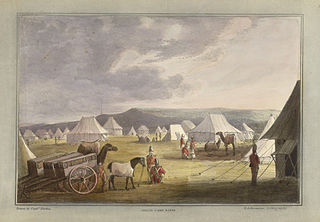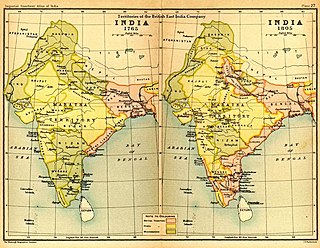
Bajirao I, born as Visaji, was the 7th Peshwa of the Maratha Confederacy. During his 20-year tenure as a Peshwa, he defeated Nizam-ul-Mulk at several battles like the Battle of Palkhed and Battle of Bhopal. Bajirao contributed to Maratha supremacy in southern India and northern India. Thus, he was responsible for establishing Maratha power in Gujarat, Malwa, Rajputana and Bundelkhand and liberating Konkan from the Siddis of Janjira and Portuguese rule.

Indore is the largest and most populous city in the Indian state of Madhya Pradesh. It is consistently ranked as the cleanest city in India. It serves as the headquarters of both the Indore District and the Indore Division. It is also considered as the state education hub and houses campuses of both the Indian Institute of Technology and the Indian Institute of Management. Located on the southern edge of Malwa Plateau, at an average altitude of 553 meters (1,814 ft) above sea level, it has the highest elevation among major cities of Central India. The city is 190 km (120 mi) west of the state capital of Bhopal. It is 57 km from Ujjain and 35 kms from Dewas. Indore had a census-estimated 2011 population of 1,994,397 and 3,570,295. The city is distributed over a land area of just 530 square kilometres (200 sq mi), making Indore the most densely populated major city in the central province.

The Third Anglo-Maratha War (1817–1819) was the final and decisive conflict between the English East India Company and the Maratha Empire in India. The war left the Company in control of most of India. It began with an invasion of Maratha territory by British East India Company troops, and although the British were outnumbered, the Maratha army was decimated. The troops were led by Governor General Hastings, supported by a force under General Thomas Hislop. Operations began against the Pindaris, a band of Muslim mercenaries and Marathas from central India.

Malwa is a historical region of west-central India occupying a plateau of volcanic origin. Geologically, the Malwa Plateau generally refers to the volcanic upland north of the Vindhya Range. Politically and administratively, it is also synonymous with the former state of Madhya Bharat which was later merged with Madhya Pradesh. At present the historical Malwa region includes districts of western Madhya Pradesh and parts of south-eastern Rajasthan. Sometimes the definition of Malwa is extended to include the Nimar region south of the Vindhyas.

Balaji Bajirao, often referred to as Nana Saheb I, was the 8th Peshwa of the Maratha Confederacy in India. He was appointed as Peshwa in 1740 upon the death of his illustrious father, the Peshwa Bajirao I.

The Holkars were a powerful family that was part of the Maratha Confederacy, which held the rank of subahdar under Peshwa Baji Rao I. When the Maratha Empire began weaker to weaken due to internal clashes, the Holkars declared themselves rulers of the Indore in Central India, which existed as an independent member of the Maratha Empire until 1818. Later, their kingdom became a princely state under the protectorate of British India.

Ahilya Bai Holkar was the hereditary noble queen of the Maratha Empire, in early-modern India. She established Maheshwar as the seat of Holkar Dynasty.
The Battle of Mahidpur was fought during the Third Anglo-Maratha War between the Holkar faction of the Maratha Confederacy and the British East India Company at Mahidpur, a town in the Malwa region, on 21 December 1817.

Malhar Rao Holkar was a noble subedar of the Maratha Empire, in present-day India. He was one of the early officers along with Ranoji Scindia to help spread the Maratha rule to northern states and was given the estate of Indore to rule by the Peshwas, during the reign of the Maratha emperor Shahu I. He was founder of the Holkar dynasty that ruled Malwa.

Gwalior state was a semi-autonomous Maratha state. It was centred in modern-day Madhya Pradesh, arising due to the rise of the Maratha Empire and fragmentation of the Mughal Empire.

Shrimant Daulat Rao Shinde was the Maharaja (ruler) of Gwalior state in central India from 1794 until his death in 1827. His reign coincided with struggles for supremacy within the Maratha Empire, and wars with the expanding East India Company. Daulatrao played a significant role in the Second and Third Anglo-Maratha wars.
Barwaha is a municipality and tehsil in Khargone district in the state of Madhya Pradesh, India. Barwaha is second biggest city of District after Khargone city. The Barwaha city is divided into 18 wards for which elections are held every 5 years. The Barwaha Municipality has population of 39,973 of which 20,940 are males while 19,033 are females as per report released by Census India 2011. Literacy rate of Barwaha is 87.27% higher than state average of 69.32%. In Barwaha, Male literacy is around 92.73% while female literacy rate is 81.23%.
Betma is a town and a nagar panchayat in Indore district in the state of Madhya Pradesh, India.

The Maratha Conquests were a series of conquests in the Indian subcontinent which led to the building of the Maratha Empire. These conquests were started by Shivaji in 1659, from the victory at the Battle of Pratapgad against Bijapur. The expansion of the empire was limited and interrupted by the Mughal conquests of south India by Mughal emperor Aurangzeb. Marathas were forced to defend their territories against the overwhelmingly strong Mughal army in the 27 years long Deccan wars. They were able to defend their territories and gain an upper hand over Mughals in the sustained conflict.

The Malwa Subah was one of the original twelve Subahs of the Mughal Empire, including Gondwana, from 1568-1743. Its seat was Ujjain. It shared borders with the autonomous and tributary chiefdoms in the east, as well as Berar, Kandesh, Ahmadnagar (Deccan), Gujarat, Ajmer, Agra, and Allahabad subahs.
Alampur is a town and a nagar panchayat in Bhind district in the Indian state of Madhya Pradesh. Alampur is known for its history, for the chhatri of Malhar Rao Holkar which is in Alampur.

Rao Nandlal Chaudhary was the chief of the Zamindars of Kampel, near Indore. He was a Gaur Brahmin. Under the suzerainty of the Mughals, he controlled Kampel and some of its surrounding area including Indore. He accepted the suzerainty of the Marathas, after the Nizam acceded to the Peshwa's demands in 1724.

Tukoji Rao Holkar, belonging to the Holkar clan of the Marathas was the feudatory of Indore. Tukoji Holkar was the adopted son of Malhar Rao Holkar, he was the second son of Shrimant Tanuji Holkar, a nephew of Malhar Rao Holkar. Thus he was also the grand-nephew of Malhar Rao Holkar. He married two wives. He had four sons Kashi Rao, Malhar Rao II Holkar, Yashwant Rao, Vithoji Rao.

Khanderao Holkar was the only son of Malhar Rao Holkar, the founder of the Holkar dynasty of Indore, and Gautama Bai. He was the husband of Ahilyabai Holkar. He served as a Maratha Sardar and fought several campaigns on behest of the Maratha empire.

















